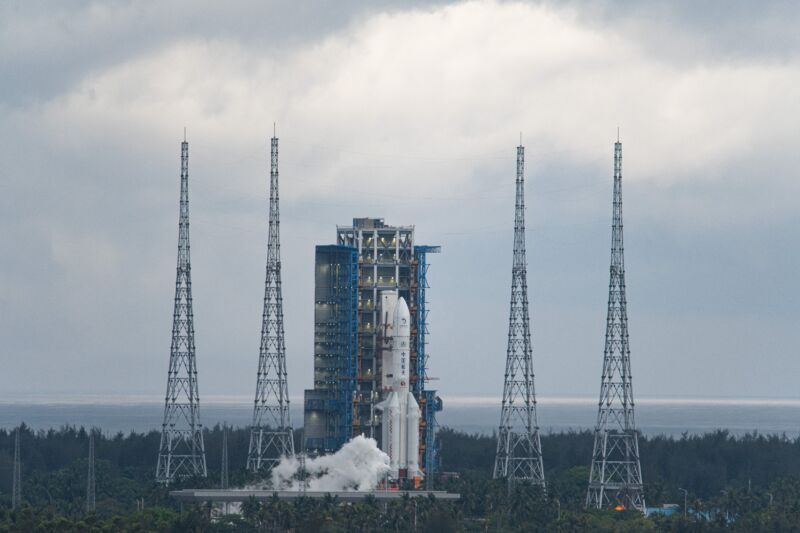
China landed a spacecraft on the Moon this weekend for the fourth time, successfully placing its Chang’e 6 lander in the South Pole-Aitken Basin on the far side of the Moon.
After the landing on Saturday evening (United States time), the autonomous spacecraft will spend about 48 hours collecting samples. It will do so by two different means, drilling to collect material from beneath the ground, as well as using a robotic arm to gather regolith from the surface.
Then a part of the spacecraft is due to blast off from the surface of the Moon—likely on Monday evening, US time—before making a return flight to China. If successful, this would be the first time samples have been returned to Earth from the far side of the Moon.
A methodical approach
This is the country's most ambitious lunar mission to date and builds step-wise on China's previous lunar spaceflights. With its Chang'e 3 mission in December 2013, the country successfully landed a small vehicle and rover on the near side of the Moon. Five years later it launched a relay spacecraft, Queqiao 1, and then the Chang'e 4 mission to the far side of the Moon. No country had landed on the far side of the Moon before, where there are no line-of-sight communications with Earth.
Then, in December 2020, China landed on the near side of the Moon with the Chang'e 5 mission. This spacecraft ultimately returned 1.7 kg of lunar dust and rocks to Earth, putting China on par with the United States and Soviet Union as the only countries to return samples from the Moon.
With its latest mission, Chang'e 6, China has put together elements of its last two lunar spacecraft, returning material from the far-less-explored far side of the Moon. Future robotic missions will focus on surveying the south pole of the Moon in anticipation of human landings.
Geopolitical implications
China has established the goal of an Apollo-like lunar landing of two astronauts on the Moon by 2030, with the eventual aim of building a "research station" at the South Pole. This could happen later in the 2030s as China continues to expand its lunar architecture. Given the country's straightforward approach so far, these timelines are realizable.
As this plays out, NASA is leading its own international program back to the Moon. NASA's efforts are messier, uniting a mix of government-only, commercial-led, and semi-private missions back to the Moon. This Artemis Program nominally has a 2026 target for an initial human landing, but no reasonable observer believes this date is real—a more realistic time frame is 2028 to 2032.
NASA's plans are considerably more complex but ultimately should be more sustainable, as they offer a mix of government and private investment. And they are more affordable in that they will employ partly or mostly reusable rockets and spacecraft. NASA is seeking to transition to reusable rockets and in-space refueling, which represents a bet on the future of space transportation rather than looking back to what worked during the Apollo era. But it is not clear whether this future of reusable spaceflight is five years away, as NASA hopes, or 20 years away.
The most dominant space storyline for the rest of this decade is how this "race" plays out, both in terms of whether China's space program or NASA reach the Moon first, and, just as critically, which of the nations has a more sustainable program. For China, mimicking the achievements of NASA's Apollo Program may be enough. For NASA, it would represent a policy failure.
A lot at stake
Although China's plan has an advantage of simplicity, Greg Autry, the director of space leadership at Thunderbird School of Global Management, Arizona State University, told Ars the United States has the right approach in the long run because its commercial and government partnerships are more robust.
"China’s human spaceflight program has been slow," said Autry, co-author of Red Moon Rising on the US-China space race. "SpaceX has flown more people to space in the last four years than China has since their program’s first flight over 20 years ago. America has better technology and a better and more diverse collection of launch vehicles and dozens of companies working on solutions to the bottlenecks we face in landers and spacesuits."
Another wrinkle in the competition is that China's authoritarian government provides stability and the advantage of long-term planning. NASA is susceptible to changing political priorities. Autry said the United States should stick to the Artemis plan, and leaders in Congress must continue to support NASA and press the agency to move with alacrity.
For symbolic reasons, Autry said, the United States needs to land humans back on the Moon before China—even if NASA did so more than five decades ago. "If China wins this race, their model of authoritarian state socialism will gain in appeal and America will look more dysfunctional than ever," he said.
Article From & Read More ( China lands on the Moon again, taking another step toward human missions - Ars Technica )https://ift.tt/A3lJyhG
Science
No comments:
Post a Comment